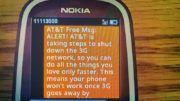In the next year, I expect that you’ll hear a lot about band 71. It’s certainly not something new, but it’s taken a while for the cellular industry to really react to it. In order to understand why we need to talk about band 71, we first need to understand what it is and why it’s a big deal.
Band 71 before there was a band 71
Band 71 is the communications industry term for a chunk of the radio frequency spectrum from 617 to 698 megahertz. These frequencies were first allocated for television use way back in 1952. Before that point, television in North America operated only on the VHF band from 44 to 216 megahertz. Even though that gave broadcasters twelve channels, most couldn’t be used in most places.
In order to keep channels from interfering with each other, a license could only be granted for a channel if there was no channel to the left or right of it within its entire broadcast area. This is why you’ll generally see that markets that have a channel 2 don’t have a channel 3. (There’s a natural gap between 4 and 5, and another one between 6 and 7.) This meant that in practice it was hard to fit more than five or six channels in those frequencies.
How band 71 came to be
In order to add more channel capacity, the FCC designated channels 14 through 83 for television broadcasting. We call these “the UHF channels.” But the FCC way overcompensated and they didn’t see cable TV or cell phones coming. They didn’t really need 69 more channels. So, between 1983 and 2011, they took away channels 51 through 83 and reallocated those frequencies to cell phones instead. And then, through a very complex process that took years to complete, they took channels 38 through 50 away too. Channel 37 is a special case, and you can read why here. The frequencies we used to think of as 38-51 were rechristened “band 71” and auctioned off to cell providers.
T-Mobile took the lion’s share of these frequencies, although AT&T, Verizon, and others got a few licenses as well. Originally these frequencies were used for LTE, but it’s more common today to see them used for 5G.
Is 5G band 71 important?
That really depends who you ask. If you ask an AT&T or Verizon customer, they’ll tell you it isn’t. They’re getting their 5G on 850MHz and 700MHz respectively. Ask cell phone signal boosters, and they’ll tell you it’s not as important as it could be. Most cell boosters today don’t work with band 71. The Wilson Pro 710i is one of the few that does. But I expect that to change.
For about three years, the FCC was limping along without a full staff. It’s just been recently that Congress has confirmed a fifth commissioner to that body. And so, it’s been very hard to get anything through if a commissioner needed to be involved. Sure, new phones and devices are approved, but in order to get new 5G cell boosters, you need a policy change that will let cell booster manufacturers actually build them. That takes some work from the folks at the top.
I fully expect to see a new generation of multi-band boosters that handle band 71 in the coming years. It doesn’t mean you should put off getting a booster today. You’ll still get clear calls and great data speeds with today’s boosters. But if you live in an area where band 71 is used for T-Mobile’s internet service, you’re going to love the new boosters.
Want to know more?
While there aren’t any consumer grade band 71 boosters yet, there are excellent solutions for businesses who want to add band 71 to the frequencies they boost. All you need to do is call an expert who can give you a personalized quote. They’ll help build the solution you really need. Call us at 888-233-7563 and we’ll get things started. If it’s after hours, fill out the form below. We’ll get right back to you!





